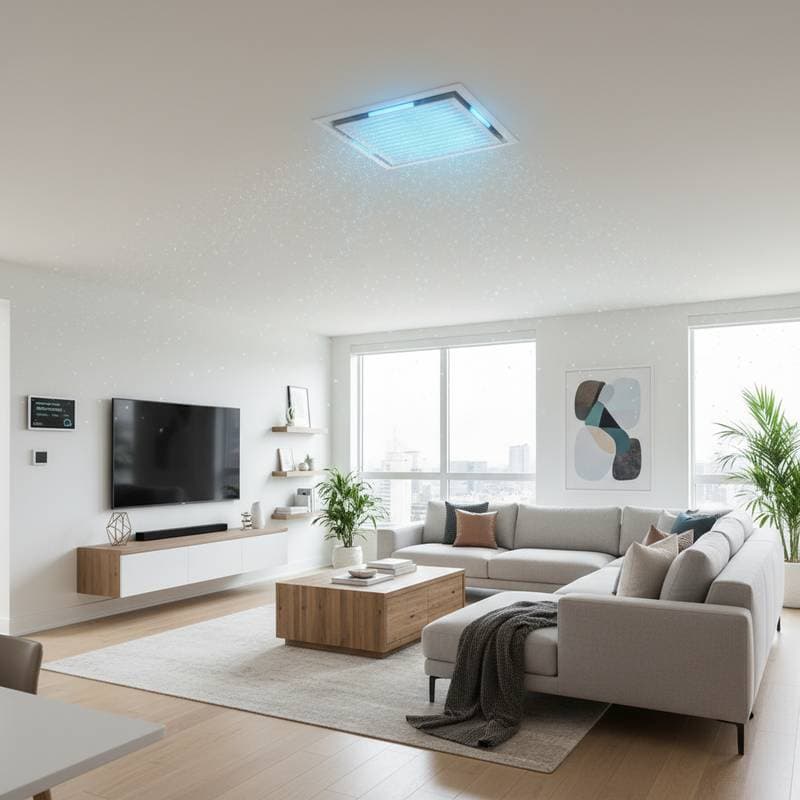Understanding HVAC Efficiency Optimization for Spring 2025
As temperatures rise and residents activate their cooling systems for intensive operation, optimizing heating, ventilation, and air conditioning (HVAC) efficiency emerges as a critical focus. An efficiently maintained HVAC setup provides reliable comfort while minimizing energy consumption and prolonging the operational life of components. Homeowners typically achieve energy cost savings of 10 to 30 percent through diligent spring maintenance.
This comprehensive guide presents eight vital steps to elevate HVAC performance during the spring period. The process encompasses cleaning protocols, thorough inspections, thermostat calibrations, duct management, and strategic planning. Applicable to diverse climates, from temperate to humid environments, these recommendations foster superior system functionality and diminished utility expenditures.
Step 1: Replace Air Filters Promptly
Air filters serve as the primary defense against dust, pollen, and allergens entering the HVAC system. Clogged filters impede airflow, compel the blower motor to labor excessively, and elevate energy usage. Spring marks an ideal time for replacement, particularly following winter inactivity when accumulated particles may have settled.
Filter Replacement Guidelines
- Identify the filter location, typically within the return air duct or furnace housing.
- Select filters with a MERV rating of 8 to 13 for balanced filtration without straining the system.
- Install the new filter with the arrow pointing toward airflow direction.
- Mark the installation date on the unit for tracking purposes.
- Dispose of the old filter responsibly to avoid indoor air contamination.
Regular filter changes enhance indoor air quality and can improve system efficiency by up to 15 percent. This foundational step ensures optimal operation from the season's outset.
Step 2: Clean the Outdoor Condenser Unit Thoroughly
The outdoor condenser unit accumulates dirt, foliage, and debris over the preceding months. Such accumulations encumber the coils, hinder heat dissipation, and prolong runtime, thereby increasing energy demands. A meticulous cleaning restores unrestricted airflow and thermal exchange.
Cleaning Procedures for the Condenser
- Disconnect power via the unit's switch or the primary circuit breaker.
- Clear surrounding vegetation and debris to maintain a minimum two-foot clearance.
- Hose down the coils with moderate water pressure to dislodge embedded particles.
- Employ a fin comb to realign any deformed fins gently.
- Inspect for corrosion or rust indicators and address minor issues promptly.
This maintenance ritual averts overheating risks and sustains cooling efficacy. A pristine condenser boosts overall energy efficiency by as much as 15 percent amid peak summer demands.
Step 3: Seal Ductwork to Prevent Leaks
Duct systems often develop leaks from age, wear, or improper installation, resulting in conditioned air loss and heightened operational strain. Sealing these pathways during spring preparation confines air distribution and amplifies system performance.
Duct Sealing Techniques
- Locate accessible ducts in attics, basements, or crawl spaces.
- Apply mastic sealant or foil tape to joints and seams, avoiding cloth-backed varieties.
- Pressurize the system with a professional duct blaster test if feasible.
- Insulate exposed ducts in unconditioned areas to curb condensation.
- Document sealed areas for future reference during inspections.
Effective duct sealing recovers up to 20 percent of lost efficiency, translating to noticeable reductions in monthly bills. This step proves especially beneficial in older homes with expansive duct networks.
Step 4: Test and Calibrate the Thermostat
An accurate thermostat regulates temperature precisely, promoting uniform comfort and averting unnecessary cycles. Spring evaluations confirm alignment between displayed and ambient temperatures, mitigating discrepancies from battery depletion or sensor drift.
Strategies for Thermostat Optimization
- Verify readings against multiple room thermometers for consistency.
- Program schedules to elevate settings during absences or sleep periods.
- Relocate units away from direct sunlight, drafts, or kitchen appliances.
- Integrate compatibility checks for zoning systems in multi-level residences.
Transitioning to a smart thermostat yields annual savings of up to 10 percent on cooling expenses. These intelligent devices adapt to occupancy patterns, optimizing energy use while preserving desired comfort levels.
Step 5: Schedule a Professional Tune-Up
Expert inspections uncover subtle issues that DIY efforts might overlook, such as refrigerant imbalances or electrical faults. A spring tune-up readies the system for summer loads, identifying wear before it escalates into costly failures.
Elements of a Comprehensive Tune-Up
- Evaluate electrical connections and capacitor functionality.
- Measure refrigerant pressures and recharge if deficiencies appear.
- Lubricate moving parts to reduce friction and noise.
- Assess blower motor performance and belt tension.
- Review safety controls and combustion processes where applicable.
Professional servicing extends equipment life by several years and prevents emergency breakdowns. Homeowners report up to 20 percent efficiency gains post-tune-up, underscoring the value of certified expertise.
Step 6: Clear and Balance Air Vents
Obstructed vents compromise airflow equilibrium, compelling the HVAC unit to compensate and heighten energy consumption. Spring assessments ensure unobstructed paths, facilitating even temperature dispersal and system relief.
Vent Inspection Protocol
- Fully open all supply and return registers throughout the dwelling.
- Vacuum covers to eliminate dust, lint, and pet dander accumulations.
- Reposition obstructing furniture, drapes, or floor coverings.
- Replace warped or deteriorated vent components for seamless integration.
- Balance dampers in branched systems to equalize pressure.
This adjustment eliminates temperature inconsistencies and curtails strain on the blower. Proper vent management contributes to a 5 to 10 percent efficiency uplift by streamlining air circulation.
Step 7: Inspect Refrigerant Levels and Coils
Refrigerant shortages diminish cooling capacity, while soiled evaporator or condenser coils impair heat absorption. Spring checks maintain charge levels and coil integrity, ensuring peak thermodynamic performance.
Refrigerant and Coil Maintenance
- Observe for frost formation or warm air output as low-charge indicators.
- Clean indoor evaporator coils with approved foam cleaners or professional assistance.
- Monitor superheat and subcooling metrics during operation.
- Avoid overcharging, which stresses compressors and voids warranties.
- Schedule annual leak detection for systems prone to gradual losses.
Adequate refrigerant and clean coils enhance efficiency by 10 to 15 percent. Addressing these elements proactively safeguards against premature component degradation.
Step 8: Enhance Insulation and Ventilation
Suboptimal insulation permits conditioned air escape, overburdening the HVAC apparatus. Ventilation upgrades mitigate moisture and heat retention, particularly in attics and crawl spaces, fostering a supportive environment for system efficacy.
Key Inspection Zones
- Gauge attic insulation thickness, aiming for R-30 to R-49 values based on climate.
- Renew weatherstripping and caulk around entry points to seal gaps.
- Probe for air infiltration at outlets, switches, and recessed lighting.
- Install ridge or soffit vents to facilitate natural attic airflow.
- Consider radiant barriers in sunny regions to reflect solar heat.
These enhancements qualify for potential rebates and reduce energy demands by up to 20 percent. Improved barriers stabilize indoor climates, easing seasonal shifts.
Overview of Spring HVAC Maintenance Expenses
Budgeting for upkeep informs decision-making. The table below details typical costs for prevalent services, aiding in financial planning.
| Maintenance Task | Average Cost | Details |
|---|---|---|
| Filter replacement | $10 to $50 | Varies by filter specifications and dimensions |
| Condenser cleaning | $75 to $150 | Encompasses coil washing and debris clearance |
| Duct sealing | $300 to $700 | Influenced by network extent and access |
| Thermostat upgrade | $100 to $300 | Includes smart model procurement and setup |
| Professional tune-up | $75 to $200 | Covers exhaustive evaluation and servicing |
| Refrigerant recharge | $150 to $600 | Based on refrigerant variety and capacity |
These estimates reflect national averages; local rates may differ.
Frequently Asked Questions on Spring HVAC Optimization
How frequently does an HVAC system require servicing?
Systems benefit from professional attention once or twice annually. Spring suits cooling components, while autumn prepares heating elements. Consistent care averts disruptions and prolongs durability.
What symptoms indicate declining HVAC efficiency?
Rising bills, inconsistent temperatures, unusual sounds, and extended cycles signal problems. Accumulations of dust, restricted filters, or imbalanced flows often underlie these manifestations. Early intervention curtails repair needs.
Which maintenance tasks suit homeowner execution?
Individuals may handle filter swaps, vent dusting, and condenser debris removal. Certified professionals must manage refrigerants, wiring, and intricate cleanings. Such self-care complements scheduled expert visits effectively.
What lifespan expects a maintained HVAC system?
Properly tended units endure 15 to 20 years. Routine checks, filter diligence, and tune-ups foster reliability and minimize outages.
How does insulation enhancement affect HVAC performance?
Superior insulation minimizes thermal loss, lightening system loads for comfort maintenance. Such improvements slash consumption by up to 20 percent, contingent on property scale and existing setup.
Securing Expert Assistance for Spring Preparations
Essential Inquiries for HVAC Contractors
- Do you hold current licensing and insurance for local HVAC operations?
- Which procedures comprise your spring maintenance package?
- Will you furnish a detailed written quote prior to commencement?
- How do you assess refrigerant integrity and electrical compliance?
- In which equipment brands do you possess specialized knowledge?
- Are maintenance agreements or seasonal promotions available?
- What duration anticipates the service visit?
- May I review testimonials from prior clients?
- What assurances or warranties accompany your work?
- Which efficiency upgrades do you suggest for my residence?
Selecting a qualified provider ensures thorough, dependable care.
Sustaining HVAC Performance Beyond Spring
Implementing these steps establishes a foundation for enduring efficiency. Monitor system indicators monthly, adhere to seasonal routines, and consult professionals for anomalies. This approach secures comfort, cost savings, and longevity year after year.





